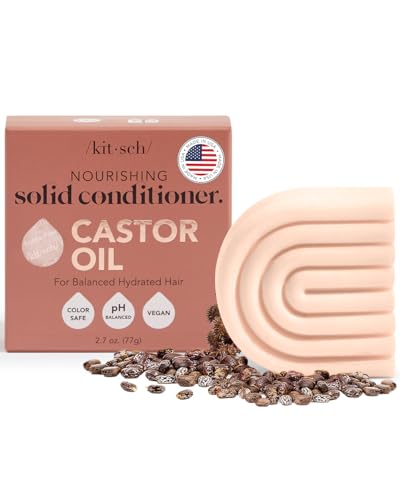

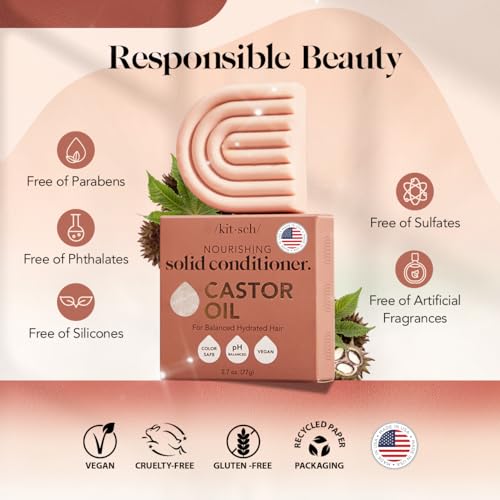
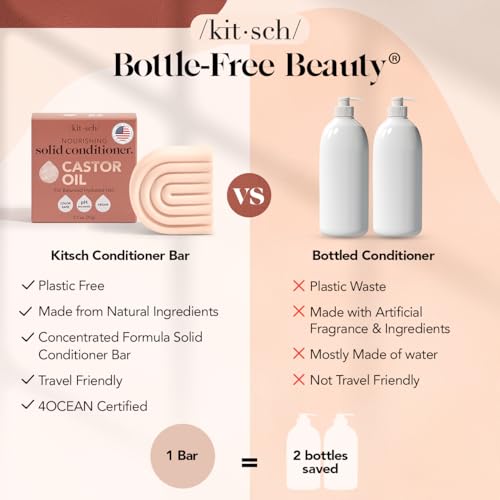

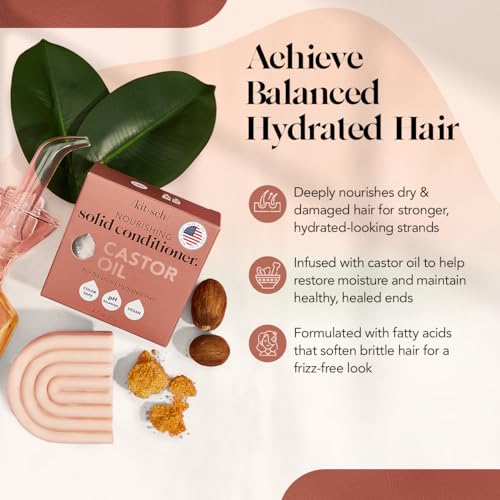

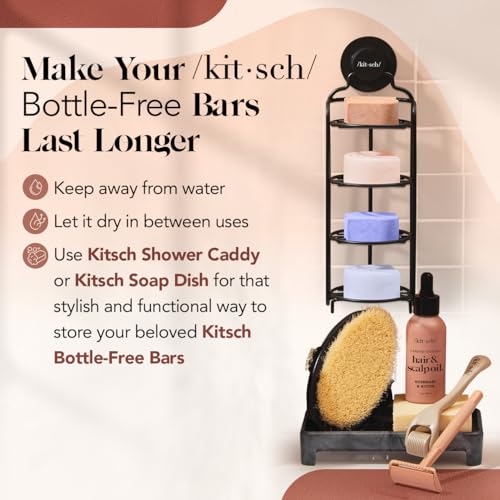
Kitsch Castor Oil Conditioner Bar - Hydrating, Nourishing, Hypoallergenic - 2.7 oz


Behentrimonium Chloride
High RiskBehentrimonium chloride is a quaternary ammonium compound primarily used as a conditioning agent in hair and skin care products. It functions as an emulsifier and surfactant, helping to improve texture and manageability of hair.
Sustai Insights
Behentrimonium chloride offers functional benefits as a hair conditioner and emulsifier. However, it is associated with moderate allergenic potential and has high use restrictions due to regulatory concerns. It poses low risks for carcinogenicity and developmental toxicity but has been noted for neurotoxicity. Environmental risks include potential pollution and low biodegradability. Overall, the ingredient is assessed as high risk, and users should consider alternatives such as natural conditioners.
Ricinus Communis (Castor) Seed Oil
Medium RiskCastor oil is extracted from the seeds of Ricinus communis and is commonly used in cosmetic and personal care products for its moisturizing and emollient properties. It is known for its ability to enhance skin absorption and provide a protective barrier.
Sustai Insights
Castor oil offers functional benefits as a moisturizer and emollient, enhancing skin absorption and providing a barrier against moisture loss. It is sustainably sourced and biodegradable. However, potential health risks include low levels of irritation and moderate concerns regarding developmental and reproductive toxicity. Environmental risks are low, with no significant pollutant or bioaccumulation concerns reported. Regulatory status shows no current restrictions. Overall, the risk level is assessed as medium, with recommendations for safe usage practices, and potential alternatives include other plant-based oils.
Lauryl Laurate
Low RiskLauryl laurate is an ester derived from lauryl alcohol and lauric acid, commonly used in cosmetic formulations as an emollient and surfactant. It contributes to the texture and spreadability of products, enhancing their overall feel on the skin.
Sustai Insights
Lauryl laurate offers functional benefits as a skin-conditioning agent and emulsifier, contributing to product stability. It is considered low risk for health concerns such as carcinogenicity, allergies, and reproductive toxicity. Environmental assessments indicate minimal pollutant potential. Regulatory bodies do not impose significant restrictions. Overall, the ingredient is deemed low risk for use in cosmetic applications, with no specific alternatives identified.
Cetearyl Alcohol
Low RiskCetearyl alcohol is a mixture of cetyl and stearyl alcohol, primarily used as an emulsifier and thickener in cosmetic formulations. It helps stabilize products, improve texture, and enhance moisturizing properties, making it common in creams and lotions.
Sustai Insights
Cetearyl alcohol offers functional benefits as an effective emulsifier and skin-conditioning agent, contributing to product stability and texture. It is generally recognized as safe, with low concerns for carcinogenicity, allergies, or reproductive toxicity. Environmental risks are minimal, as it is biodegradable and has low pollutant potential. Regulatory bodies have not imposed significant restrictions on its use. Overall, cetearyl alcohol is assessed to carry low risk, making it a suitable ingredient choice in cosmetic products.
Sodium Acetylhyaluronate
Low RiskSodium acetylhyaluronate is a sodium salt derivative of hyaluronic acid, commonly used in cosmetic formulations for its hydrating properties. It functions primarily as a humectant, attracting moisture to the skin and helping to maintain hydration levels in various personal care products.
Sustai Insights
Sodium acetylhyaluronate is recognized for its effective moisture-retaining properties, enhancing skin hydration and improving product texture. It has low health risks, with negligible concerns regarding carcinogenicity, allergies, or reproductive toxicity. Environmentally, it poses minimal risks and is not associated with significant pollution or bioaccumulation. Regulatory assessments indicate no current restrictions. Overall, it is considered low risk, making it a favorable ingredient in cosmetic formulations.
Panthenol, D
Low RiskPanthenol, also known as provitamin B5, is a humectant commonly used in cosmetic and personal care products. It functions primarily as a moisturizer, enhancing skin hydration and improving the appearance of hair by imparting shine and softness.
Sustai Insights
Panthenol is effective in retaining moisture, thus providing functional benefits for skin and hair care products. It is generally recognized as safe, with low concerns regarding carcinogenicity, allergies, and developmental toxicity. However, potential cumulative exposure from multiple sources exists. Environmental risks are minimal, and it is not bioaccumulative. Regulatory bodies have not issued significant warnings; therefore, the overall risk level is assessed as low. For optimal use, it is recommended to follow product guidelines, and alternatives such as glycerin may also be considered for moisturizing effects.
Hydrogenated Ethylhexyl Olivate
Low RiskHydrogenated ethylhexyl olivate is a mixture of ethylhexyl alcohol and olive oil fatty acids. It functions mainly as an emollient, providing skin conditioning and moisturizing properties in cosmetic formulations.
Sustai Insights
Hydrogenated ethylhexyl olivate serves as an effective emollient, enhancing skin hydration and texture. It is not associated with significant health risks, as concerns regarding carcinogenicity, allergies, or reproductive toxicity are low. Environmentally, it poses minimal risks, with no evidence of bioaccumulation. Regulatory assessments do not highlight any restrictions. Overall, it is regarded as low-risk, making it a safe choice in cosmetic products.
Hexanediol
Low RiskHexanediol is a synthetic diol commonly used in cosmetics and personal care products primarily as a solvent, humectant, and skin conditioning agent. It aids in maintaining moisture and enhancing product texture.
Sustai Insights
Hexanediol is known for its effective moisture-retaining properties, making it beneficial in skin formulations. It is considered low risk concerning health impacts, with minimal concerns regarding carcinogenicity, allergies, and reproductive toxicity. Environmentally, it poses low pollution risk and is not bioaccumulative. Regulatory bodies have not flagged significant restrictions, supporting its safety profile. Safe usage practices are recommended to ensure proper application. Overall, hexanediol presents a low-risk profile regarding health and environmental concerns.
Cocos Nucifera (Coconut) Oil
Low RiskCocos Nucifera (Coconut) Oil is derived from the kernels of the coconut palm. It is primarily used in cosmetic formulations for its emollient and moisturizing properties, making it suitable for skin and hair care products.
Sustai Insights
Coconut oil serves as an effective moisturizer and emollient, promoting skin hydration and softness. It is sustainably sourced and biodegradable. Health risks are minimal, with low concerns regarding carcinogenicity, allergens, and reproductive toxicity. Environmental impact is also low, as it does not contribute significantly to pollution or bioaccumulation. Regulatory bodies have not issued restrictions on its use. Overall, coconut oil presents a low risk for health and environmental concerns, making it a safe ingredient in cosmetic products.
Guar Hydroxypropyltrimonium Chloride
Low RiskGuar hydroxypropyltrimonium chloride is a quaternary ammonium compound derived from guar gum, primarily used as a conditioning agent in cosmetic products. It enhances the texture and feel of hair and skin formulations, providing moisture retention and improved manageability.
Sustai Insights
This ingredient offers functional benefits as a conditioning agent, improving the texture and moisture retention in formulations. It is considered low risk regarding health effects, with minimal concerns for carcinogenicity, allergies, or reproductive toxicity. Environmental risks are also low, as it does not accumulate significantly in ecosystems. Regulatory bodies have not imposed significant restrictions. Safe usage practices should be followed, but overall, this ingredient is assessed as low risk, with no immediate concerns regarding alternatives.
Hydrogenated Olive Oil Unsaponifiables
Low RiskHydrogenated olive oil unsaponifiables are derived from the hydrogenation of olive oil, resulting in a semi-solid or solid fat. They are primarily used in cosmetic formulations for their emollient properties, enhancing skin moisture retention and providing a smooth texture.
Sustai Insights
Hydrogenated olive oil unsaponifiables offer functional benefits as effective emollients that enhance skin hydration. They are considered low risk for common health concerns such as carcinogenicity, allergies, and reproductive toxicity. Environmental impact is also minimal, with no significant pollutant or bioaccumulative potential. Regulatory bodies have not placed restrictions on their use. Safe usage practices should be followed, and while alternatives exist, this ingredient is deemed suitable for various cosmetic applications, leading to an overall low risk assessment.
Water
Low RiskWater is a clear, colorless liquid essential for various biological processes. It serves as a solvent in formulations, facilitating the dissolution of other ingredients and enhancing product texture and application. Additionally, water plays a crucial role in hydration and is a key component in many cosmetic and personal care products.
Sustai Insights
Water is an effective solvent and hydrator, contributing to the texture and efficacy of formulations. It is biodegradable and generally regarded as safe, with low concerns regarding carcinogenicity, allergies, and reproductive toxicity. However, excessive water usage can lead to environmental concerns, particularly regarding resource depletion. Regulatory bodies do not impose restrictions on water use in cosmetics. Overall, the risks associated with water are low, making it a safe and essential ingredient.
Helianthus Annuus (Sunflower) Seed
Low RiskHelianthus annuus (sunflower) seed is derived from the seeds of the sunflower plant and is commonly used in various cosmetic and personal care products. It serves primarily as an emollient and skin conditioning agent, providing moisture and enhancing the texture of formulations.
Sustai Insights
Helianthus annuus (sunflower) seed offers functional benefits, including skin conditioning and moisturizing properties, while being sustainably sourced and biodegradable. Health risks are minimal, with low concerns for carcinogenicity, allergies, and reproductive toxicity. Environmentally, it presents low risks of pollution or bioaccumulation. Regulatory assessments indicate no current restrictions. Overall, it is considered a low-risk ingredient, and safe usage practices should be maintained. Alternative ingredients may include other plant-based oils, but the sunflower seed oil remains a viable option.
Hydrolyzed Quinoa
Low RiskHydrolyzed quinoa is a hydrolysate derived from quinoa grains, often used in cosmetic and personal care products for its moisturizing and conditioning properties. It is known for enhancing the texture and hydration of formulations, contributing to the overall performance of products.
Sustai Insights
Hydrolyzed quinoa offers functional benefits by acting as an effective moisturizer and conditioning agent in formulations, enhancing skin and hair texture. It is sustainably sourced and biodegradable, posing low health risks, including minimal concerns for carcinogenicity, allergies, and reproductive toxicity. Environmental risks are also low, with no significant pollutants or bioaccumulation observed. Regulatory assessments indicate no current restrictions. Overall, hydrolyzed quinoa presents a low-risk profile, making it a suitable ingredient in cosmetic applications.
Lauryl Laurate
Low RiskLauryl laurate is an ester derived from lauryl alcohol and lauric acid, commonly used in cosmetic formulations as an emollient and surfactant. It contributes to the texture and spreadability of products, enhancing their overall feel on the skin.
Sustai Insights
Lauryl laurate offers functional benefits as a skin-conditioning agent and emulsifier, contributing to product stability. It is considered low risk for health concerns such as carcinogenicity, allergies, and reproductive toxicity. Environmental assessments indicate minimal pollutant potential. Regulatory bodies do not impose significant restrictions. Overall, the ingredient is deemed low risk for use in cosmetic applications, with no specific alternatives identified.
Cetearyl Alcohol
Low RiskCetearyl alcohol is a mixture of cetyl and stearyl alcohol, primarily used as an emulsifier and thickener in cosmetic formulations. It helps stabilize products, improve texture, and enhance moisturizing properties, making it common in creams and lotions.
Sustai Insights
Cetearyl alcohol offers functional benefits as an effective emulsifier and skin-conditioning agent, contributing to product stability and texture. It is generally recognized as safe, with low concerns for carcinogenicity, allergies, or reproductive toxicity. Environmental risks are minimal, as it is biodegradable and has low pollutant potential. Regulatory bodies have not imposed significant restrictions on its use. Overall, cetearyl alcohol is assessed to carry low risk, making it a suitable ingredient choice in cosmetic products.
Sodium Acetylhyaluronate
Low RiskSodium acetylhyaluronate is a sodium salt derivative of hyaluronic acid, commonly used in cosmetic formulations for its hydrating properties. It functions primarily as a humectant, attracting moisture to the skin and helping to maintain hydration levels in various personal care products.
Sustai Insights
Sodium acetylhyaluronate is recognized for its effective moisture-retaining properties, enhancing skin hydration and improving product texture. It has low health risks, with negligible concerns regarding carcinogenicity, allergies, or reproductive toxicity. Environmentally, it poses minimal risks and is not associated with significant pollution or bioaccumulation. Regulatory assessments indicate no current restrictions. Overall, it is considered low risk, making it a favorable ingredient in cosmetic formulations.
Panthenol, D
Low RiskPanthenol, also known as provitamin B5, is a humectant commonly used in cosmetic and personal care products. It functions primarily as a moisturizer, enhancing skin hydration and improving the appearance of hair by imparting shine and softness.
Sustai Insights
Panthenol is effective in retaining moisture, thus providing functional benefits for skin and hair care products. It is generally recognized as safe, with low concerns regarding carcinogenicity, allergies, and developmental toxicity. However, potential cumulative exposure from multiple sources exists. Environmental risks are minimal, and it is not bioaccumulative. Regulatory bodies have not issued significant warnings; therefore, the overall risk level is assessed as low. For optimal use, it is recommended to follow product guidelines, and alternatives such as glycerin may also be considered for moisturizing effects.
Hydrogenated Ethylhexyl Olivate
Low RiskHydrogenated ethylhexyl olivate is a mixture of ethylhexyl alcohol and olive oil fatty acids. It functions mainly as an emollient, providing skin conditioning and moisturizing properties in cosmetic formulations.
Sustai Insights
Hydrogenated ethylhexyl olivate serves as an effective emollient, enhancing skin hydration and texture. It is not associated with significant health risks, as concerns regarding carcinogenicity, allergies, or reproductive toxicity are low. Environmentally, it poses minimal risks, with no evidence of bioaccumulation. Regulatory assessments do not highlight any restrictions. Overall, it is regarded as low-risk, making it a safe choice in cosmetic products.
Hexanediol
Low RiskHexanediol is a synthetic diol commonly used in cosmetics and personal care products primarily as a solvent, humectant, and skin conditioning agent. It aids in maintaining moisture and enhancing product texture.
Sustai Insights
Hexanediol is known for its effective moisture-retaining properties, making it beneficial in skin formulations. It is considered low risk concerning health impacts, with minimal concerns regarding carcinogenicity, allergies, and reproductive toxicity. Environmentally, it poses low pollution risk and is not bioaccumulative. Regulatory bodies have not flagged significant restrictions, supporting its safety profile. Safe usage practices are recommended to ensure proper application. Overall, hexanediol presents a low-risk profile regarding health and environmental concerns.
Cocos Nucifera (Coconut) Oil
Low RiskCocos Nucifera (Coconut) Oil is derived from the kernels of the coconut palm. It is primarily used in cosmetic formulations for its emollient and moisturizing properties, making it suitable for skin and hair care products.
Sustai Insights
Coconut oil serves as an effective moisturizer and emollient, promoting skin hydration and softness. It is sustainably sourced and biodegradable. Health risks are minimal, with low concerns regarding carcinogenicity, allergens, and reproductive toxicity. Environmental impact is also low, as it does not contribute significantly to pollution or bioaccumulation. Regulatory bodies have not issued restrictions on its use. Overall, coconut oil presents a low risk for health and environmental concerns, making it a safe ingredient in cosmetic products.
Guar Hydroxypropyltrimonium Chloride
Low RiskGuar hydroxypropyltrimonium chloride is a quaternary ammonium compound derived from guar gum, primarily used as a conditioning agent in cosmetic products. It enhances the texture and feel of hair and skin formulations, providing moisture retention and improved manageability.
Sustai Insights
This ingredient offers functional benefits as a conditioning agent, improving the texture and moisture retention in formulations. It is considered low risk regarding health effects, with minimal concerns for carcinogenicity, allergies, or reproductive toxicity. Environmental risks are also low, as it does not accumulate significantly in ecosystems. Regulatory bodies have not imposed significant restrictions. Safe usage practices should be followed, but overall, this ingredient is assessed as low risk, with no immediate concerns regarding alternatives.
Hydrogenated Olive Oil Unsaponifiables
Low RiskHydrogenated olive oil unsaponifiables are derived from the hydrogenation of olive oil, resulting in a semi-solid or solid fat. They are primarily used in cosmetic formulations for their emollient properties, enhancing skin moisture retention and providing a smooth texture.
Sustai Insights
Hydrogenated olive oil unsaponifiables offer functional benefits as effective emollients that enhance skin hydration. They are considered low risk for common health concerns such as carcinogenicity, allergies, and reproductive toxicity. Environmental impact is also minimal, with no significant pollutant or bioaccumulative potential. Regulatory bodies have not placed restrictions on their use. Safe usage practices should be followed, and while alternatives exist, this ingredient is deemed suitable for various cosmetic applications, leading to an overall low risk assessment.
Water
Low RiskWater is a clear, colorless liquid essential for various biological processes. It serves as a solvent in formulations, facilitating the dissolution of other ingredients and enhancing product texture and application. Additionally, water plays a crucial role in hydration and is a key component in many cosmetic and personal care products.
Sustai Insights
Water is an effective solvent and hydrator, contributing to the texture and efficacy of formulations. It is biodegradable and generally regarded as safe, with low concerns regarding carcinogenicity, allergies, and reproductive toxicity. However, excessive water usage can lead to environmental concerns, particularly regarding resource depletion. Regulatory bodies do not impose restrictions on water use in cosmetics. Overall, the risks associated with water are low, making it a safe and essential ingredient.
Helianthus Annuus (Sunflower) Seed
Low RiskHelianthus annuus (sunflower) seed is derived from the seeds of the sunflower plant and is commonly used in various cosmetic and personal care products. It serves primarily as an emollient and skin conditioning agent, providing moisture and enhancing the texture of formulations.
Sustai Insights
Helianthus annuus (sunflower) seed offers functional benefits, including skin conditioning and moisturizing properties, while being sustainably sourced and biodegradable. Health risks are minimal, with low concerns for carcinogenicity, allergies, and reproductive toxicity. Environmentally, it presents low risks of pollution or bioaccumulation. Regulatory assessments indicate no current restrictions. Overall, it is considered a low-risk ingredient, and safe usage practices should be maintained. Alternative ingredients may include other plant-based oils, but the sunflower seed oil remains a viable option.
Hydrolyzed Quinoa
Low RiskHydrolyzed quinoa is a hydrolysate derived from quinoa grains, often used in cosmetic and personal care products for its moisturizing and conditioning properties. It is known for enhancing the texture and hydration of formulations, contributing to the overall performance of products.
Sustai Insights
Hydrolyzed quinoa offers functional benefits by acting as an effective moisturizer and conditioning agent in formulations, enhancing skin and hair texture. It is sustainably sourced and biodegradable, posing low health risks, including minimal concerns for carcinogenicity, allergies, and reproductive toxicity. Environmental risks are also low, with no significant pollutants or bioaccumulation observed. Regulatory assessments indicate no current restrictions. Overall, hydrolyzed quinoa presents a low-risk profile, making it a suitable ingredient in cosmetic applications.
Behentrimonium Chloride
High RiskBehentrimonium chloride is a quaternary ammonium compound primarily used as a conditioning agent in hair and skin care products. It functions as an emulsifier and surfactant, helping to improve texture and manageability of hair.
Sustai Insights
Behentrimonium chloride offers functional benefits as a hair conditioner and emulsifier. However, it is associated with moderate allergenic potential and has high use restrictions due to regulatory concerns. It poses low risks for carcinogenicity and developmental toxicity but has been noted for neurotoxicity. Environmental risks include potential pollution and low biodegradability. Overall, the ingredient is assessed as high risk, and users should consider alternatives such as natural conditioners.
Ricinus Communis (Castor) Seed Oil
Medium RiskCastor oil is extracted from the seeds of Ricinus communis and is commonly used in cosmetic and personal care products for its moisturizing and emollient properties. It is known for its ability to enhance skin absorption and provide a protective barrier.
Sustai Insights
Castor oil offers functional benefits as a moisturizer and emollient, enhancing skin absorption and providing a barrier against moisture loss. It is sustainably sourced and biodegradable. However, potential health risks include low levels of irritation and moderate concerns regarding developmental and reproductive toxicity. Environmental risks are low, with no significant pollutant or bioaccumulation concerns reported. Regulatory status shows no current restrictions. Overall, the risk level is assessed as medium, with recommendations for safe usage practices, and potential alternatives include other plant-based oils.
Experience the nourishing power of the Kitsch Castor Oil Hair Conditioner Bar, designed for effortlessly smooth and hydrated hair. This eco-friendly, vegan conditioner bar is perfect for all hair types, from curly to straight, ensuring a gentle and effective treatment without any plastic waste.
- Effortless Detangling & Deep Nourishment: Infused with castor oil, this bar nourishes and detangles, leaving hair manageable and free of buildup.
- Long-Lasting & Eco-Friendly: Enjoy the concentrated formula that lasts as long as two bottles of liquid conditioner, reducing waste and travel hassle.
- Gentle & Safe for Sensitive Scalps: Made with hypoallergenic ingredients, it's pH balanced and safe for color-treated hair, ensuring no irritation.
- Ethically Made & Ocean-Friendly: Proudly vegan and cruelty-free, your purchase supports ocean cleanup efforts through 4ocean, removing plastic from our waters.
- Convenient Travel Size: Compact and spill-proof, this conditioner bar includes a storage tin, making it ideal for on-the-go hydration.
Revolutionize your hair care routine with this sustainable option that cares for your hair and the planet.
Subscribe & Save with Sustai
- Best Price Guarantee: Always enjoy the lowest prices on sustainable home essentials.
- No Surprises: We’ll notify you before shipping. No hidden fees, ever.
- You’re in Charge: Change, pause, or cancel your subscription anytime with ease.
- Eco-Friendly Deliveries: Our grouped shipments mean less packaging and lower emissions.
Join us on a sustainable journey. Special offers for a limited time! Prices and promotions may change.
Recommended Products
Experience the nourishing power of the Kitsch Castor Oil Hair Conditioner Bar, designed for effortlessly smooth and hydrated hair. This eco-friendly, vegan conditioner bar is perfect for all hair types, from curly to straight, ensuring a gentle and effective treatment without any plastic waste.
- Effortless Detangling & Deep Nourishment: Infused with castor oil, this bar nourishes and detangles, leaving hair manageable and free of buildup.
- Long-Lasting & Eco-Friendly: Enjoy the concentrated formula that lasts as long as two bottles of liquid conditioner, reducing waste and travel hassle.
- Gentle & Safe for Sensitive Scalps: Made with hypoallergenic ingredients, it's pH balanced and safe for color-treated hair, ensuring no irritation.
- Ethically Made & Ocean-Friendly: Proudly vegan and cruelty-free, your purchase supports ocean cleanup efforts through 4ocean, removing plastic from our waters.
- Convenient Travel Size: Compact and spill-proof, this conditioner bar includes a storage tin, making it ideal for on-the-go hydration.
Revolutionize your hair care routine with this sustainable option that cares for your hair and the planet.

You can have at most 2 Sustainable Steals products in your cart
Customer Reviews
Customers’ View
Customers appreciate the effectiveness and eco-friendly nature of the Kitsch Conditioner Bar. Many users highlight its ability to provide deep nourishment, with one stating it leaves hair 'soft, shiny, and feeling clean.' The compact, travel-friendly design and zero-waste packaging resonate with environmentally conscious consumers, helping reduce plastic waste. Users with wavy and curly hair report that it enhances bounce and definition, noting that their curls remain light and manageable. Some customers mention minor issues with the bar crumbling or difficulty rinsing out, but overall, the positive feedback reflects satisfaction with its performance and commitment to sustainability. Overall, customers find this product both effective and aligned with their sustainable lifestyle.
AI-generated from the text of customer reviewsThis product is rated 4.6 of 5.0 stars.
It has received 17 reviews.




